
Content
Attention:this article is intended for people over 18 years of age.
Lambic is a unique beer made according to old recipes that differ significantly from modern lagers and ales. Authentic lambic is produced only in Belgium in the Seine Valley, near Brussels. The lambic recipe is unusual because it has been brewed since ancient times using a spontaneous fermentation method using wild yeast and bacteria. Yeast lives in the air, as well as in brewing equipment and building elements of breweries, such as ramshackle roofs. The specific microbiological climate of the Seine Valley allows for the creation of true lambic, which cannot be recreated elsewhere. Brewing equipment, in which yeast and bacteria live, is never thoroughly cleaned and sanitized. The breweries are kept in this condition in order not to lose elements of important flora. This is very different from modern breweries, which produce ales and lagers using pure, laboratory-produced yeast strains and continually make sure the beer is not contaminated with bacteria. Also, for the production of lambic, special hops, aged for several years, are used.Unlike hops, which are used to make regular beer, lambic hops do not impart a bitter taste to the beverage. It is mainly used as a preservative. The unconventional nature of lambic makes it a very difficult drink to make, and the richness of its taste can only be experienced from glassware and at a certain temperature.
Steps
- 1 Find a real lambic. Real lambic can only be sourced from Belgium, and the words Lambic (Lambiek) must be on the label. Beer that has undergone spontaneous fermentation and is not produced in Belgium cannot be real lambic. Lambic is usually aged for six months to three years, with young and old lambic usually being blended. Lambic is made from natural ingredients and does not contain artificial colors or flavors. The ingredients are usually written on the bottle, so look for the following ingredients: barley, wheat, and aged hops. Fresh whole fruits are also included and added during fermentation as they are rich in sugar. Before bottling, unfermented residues are removed from the beer. Buy beer that is bottled in 0.33L bottles or in 0.75L champagne bottles. Bottles are corked like wine or champagne, some have a second on top of the first, like a regular beer bottle. You won't be able to see the plug until you remove the regular cap.
- Fruit lambic is commonly labeled kriek, pecheresse, peche, framboise, or cassis. These names correspond to the fruit that the lambic is made from, and the fruit itself is usually painted on the label.
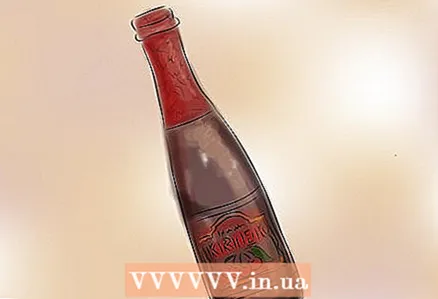
- Gueuze and Faro are traditional types of lambic that do not use fruit. Gueuze is usually a mixture of several one-year, two-year, and three-year lambics. Gueuze is quite sour or tart in taste, while faro is sweet, since sugar is used in its manufacture. The sour and tart taste is the result of certain bacteria, such as acetic acid and lactic acid, that cause the beer to ferment.

- Pure lambic is usually a six-month-old drink with very little gas. Other types are usually carbonated.

- Fruit lambic is commonly labeled kriek, pecheresse, peche, framboise, or cassis. These names correspond to the fruit that the lambic is made from, and the fruit itself is usually painted on the label.
 2 Chill the drink to the required temperature. The temperature should be between 4 and 12 degrees Celsius. Use lower temperatures for fruit lambics, and higher temperatures for gueuze, faro, or pure lambic. High temperatures help to reveal the aroma and taste of beer, made in the presence of many microorganisms that are involved in the fermentation of the drink. Oak barrels, long aging, ingredients used are also factors that influence the aroma and taste of beer. If the lambic has been in the refrigerator, take out the bottle and wait a little for it to warm to room temperature, and only then open it and pour it into glasses.
2 Chill the drink to the required temperature. The temperature should be between 4 and 12 degrees Celsius. Use lower temperatures for fruit lambics, and higher temperatures for gueuze, faro, or pure lambic. High temperatures help to reveal the aroma and taste of beer, made in the presence of many microorganisms that are involved in the fermentation of the drink. Oak barrels, long aging, ingredients used are also factors that influence the aroma and taste of beer. If the lambic has been in the refrigerator, take out the bottle and wait a little for it to warm to room temperature, and only then open it and pour it into glasses.  3 Find the correct container. Use tulip glasses, wine glasses, fruit lambic and gueuze stem glasses. Use a glass of flutes for gueuze, fruit lambic and faro. You can serve pure lambic in a barbell or in a flut glass. Alternatively, you can choose glasses according to your personal taste preferences. Your choice can affect, even slightly, the aroma and taste of the drink, and some types of lambic will change the taste depending on the glass you choose. Alternatively, you can use a Collins glass instead of a barbell glass. Certain types of lambic are paired with a signature glass provided by the brewery. Get a glass of the size you need. But keep in mind that most lambics are highly carbonated and foamy. Lambic is usually served with foam.
3 Find the correct container. Use tulip glasses, wine glasses, fruit lambic and gueuze stem glasses. Use a glass of flutes for gueuze, fruit lambic and faro. You can serve pure lambic in a barbell or in a flut glass. Alternatively, you can choose glasses according to your personal taste preferences. Your choice can affect, even slightly, the aroma and taste of the drink, and some types of lambic will change the taste depending on the glass you choose. Alternatively, you can use a Collins glass instead of a barbell glass. Certain types of lambic are paired with a signature glass provided by the brewery. Get a glass of the size you need. But keep in mind that most lambics are highly carbonated and foamy. Lambic is usually served with foam. 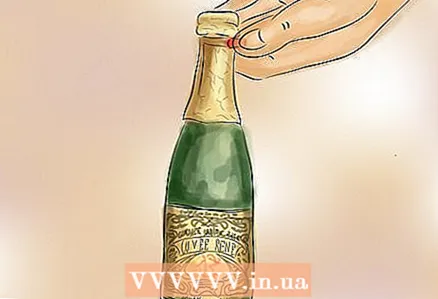 4 Peel off the foil if necessary. Cut or tear off the foil that is wrapped around the neck. Cut off the top with a knife, or just gently tear off the foil. Alternatively, you can remove the cover without removing the foil. Usually, the foil shouldn't interfere with this process. However, be aware that the bottle opener may slip if you did not remove the foil initially.
4 Peel off the foil if necessary. Cut or tear off the foil that is wrapped around the neck. Cut off the top with a knife, or just gently tear off the foil. Alternatively, you can remove the cover without removing the foil. Usually, the foil shouldn't interfere with this process. However, be aware that the bottle opener may slip if you did not remove the foil initially. 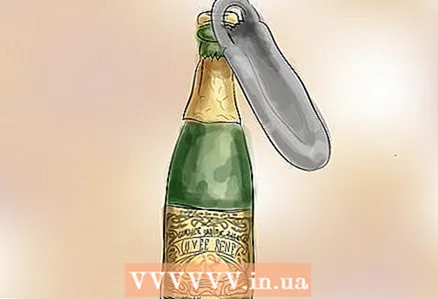 5 Remove the cover . If there is a cap, remove it with a bottle opener. Keep in mind that these bottles usually have larger cap diameters than standard beer bottles. Therefore, a regular opener may not work.
5 Remove the cover . If there is a cap, remove it with a bottle opener. Keep in mind that these bottles usually have larger cap diameters than standard beer bottles. Therefore, a regular opener may not work. - Use the large bottle openers commonly used by bartenders.
 6 Uncork the bottle . The bottle can be corked like wine or champagne bottles. If there is a plug under the cap, use a corkscrew to remove it.
6 Uncork the bottle . The bottle can be corked like wine or champagne bottles. If there is a plug under the cap, use a corkscrew to remove it. - The corks, like those found in champagne bottles, must remain tied with wire until the bottle is opened. Otherwise, the cork may shoot.

- In order to uncork such a plug, remove the wire.
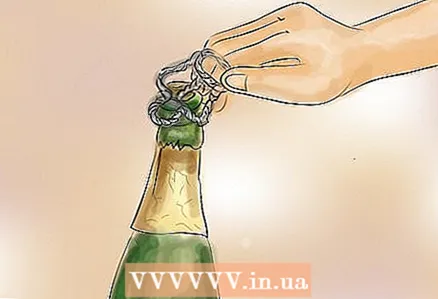
- Then, use your fingers to pull out the plug. When pulling out, you need to firmly hold the protruding part of the cork with your hand, and slowly turn the bottle with the other hand. As soon as the cork gave in, you should press it with your hand so that it does not fly out, and then quietly remove it. Use a napkin or towel to support the cork.

- Be careful, the drink is highly carbonated and produces a copious foam. Do not shake the bottle. Otherwise, most of the beer will end up on the floor and clothes.

- The corks, like those found in champagne bottles, must remain tied with wire until the bottle is opened. Otherwise, the cork may shoot.
- 7 Pour the labmik. As mentioned above, the lambic drink is highly carbonated, pour it carefully, otherwise, in the end, there will be more foam in the glass than beer. Due to the fact that beer undergoes spontaneous natural fermentation, the amount of foam will differ even for the same varieties from the same manufacturer.
- Pour slowly while holding the glass at an angle. This will help reduce foaming.

- When the glass is almost half full, gradually return it to an upright position. Thanks to this, you can achieve the required amount of thick foam. Pouring too quickly will result in more foam in the glass than beer. Therefore, when pouring lambic, keep the bottle as close to the glass as possible and pour the drink very slowly. Most of the glass should be foam, which looks very appetizing and is also an integral part of lambic beer.

- When you first pour the lambic, it may look a little cloudy. This is normal for this drink. Unrefined lambic has sediment at the bottom of the bottle, which often results in a slight haze in the beverage. To avoid this, do not shake the bottle, before pouring the drink into glasses, pour gradually, without tilting the bottle too much or pouring the sediment into the glass. Bacteria present during fermentation can also cause the cloudy color. The presence of a slight sediment and a cloudy shade is considered the norm. Purified lambic is not unusual, so don't be surprised if one lambic is cloudy and the other isn't. In addition, unrefined lambic can be clear if the bottle is not shaken before bottling and the beverage is poured very slowly so that the particles can naturally settle. In this case, the lambic will not be cloudy. Fruit lambic can be quite dark depending on the type of fruit used.
- Pour slowly while holding the glass at an angle. This will help reduce foaming.
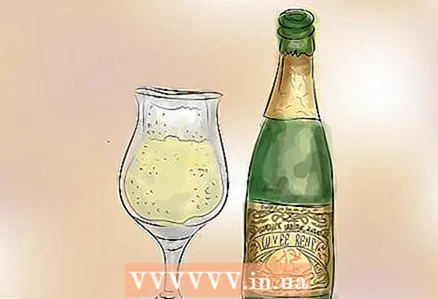 8 Lambic smell and taste . The aroma is generally described as fruity, lemon, tart and sour. Lambic can be sour and tart, or it can resemble sherry or cider. You may feel a little bitterness, or you may not feel it at all. The unwanted aroma is described as smoky, vinegar, and cheesy. In addition, very sweet fruit lambics with added sugar are produced for the American market, however authentic fruit lambics such as Cantillon or Hanssens have a slight natural sweetness from fresh fruit and fruit juices. The flavor and color depends on the fruit that was used during the production of the fruit lambic.
8 Lambic smell and taste . The aroma is generally described as fruity, lemon, tart and sour. Lambic can be sour and tart, or it can resemble sherry or cider. You may feel a little bitterness, or you may not feel it at all. The unwanted aroma is described as smoky, vinegar, and cheesy. In addition, very sweet fruit lambics with added sugar are produced for the American market, however authentic fruit lambics such as Cantillon or Hanssens have a slight natural sweetness from fresh fruit and fruit juices. The flavor and color depends on the fruit that was used during the production of the fruit lambic.
Tips
- Pay attention to the ingredients in lambic. As a rule, the composition of the drink is indicated on the label on the bottle. Make sure the drink contains natural ingredients such as barley, wheat, and fresh fruit.
- Lambics usually contain live bacteria.To avoid killing bacteria, do not expose your beer to high temperatures. Store lambics in cool, dark places.
- Not all lambics are created equal! There are bad examples as well as good ones - classic lambics (just like other beers). Chapeau & most Lindeman (exception: Gueuze Cuvee Rene) have a sweet, fruity flavor. If you want to taste the classic version of this drink, pick up the best varieties such as: Cantillon, Boon (especially Marriage Parfait!), And Hanssens. These lambics have a more tart, sour, and fruity flavor. Enjoy!
- Lambics contain a wide variety of microorganisms. However, this beer is not harmful as it has low pH and alcohol levels. This inhibits the growth of harmful microorganisms.
- It is not necessary to follow every advice here. Open the bottle whichever is more convenient for you. Alternatively, you can drink from the glasses that you have available.
- When opening the plug, do not remove the wire immediately. Use it to hold the cork as it can fly out with violent force.
Warnings
- Do not drink alcoholic beverages while driving.
- When opening the plug, be careful that it does not fly and cause injury to someone.
- Know your measure.



